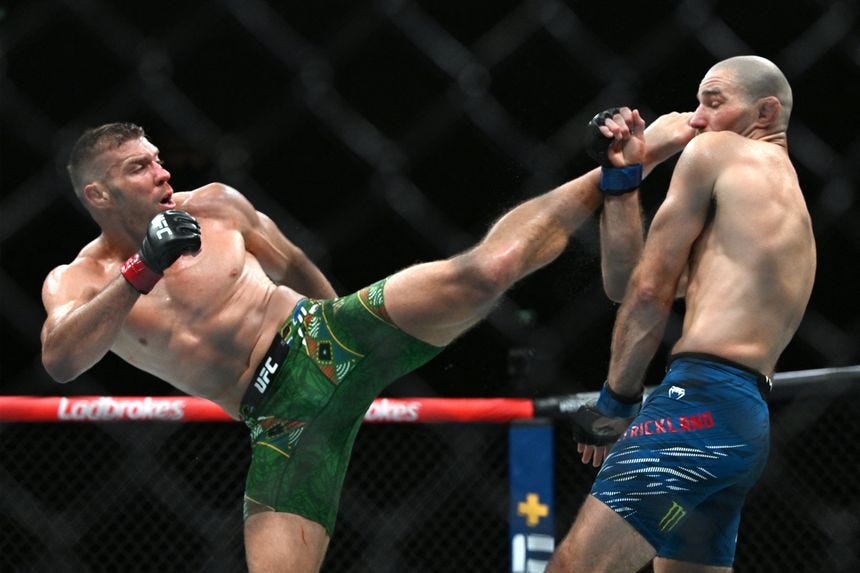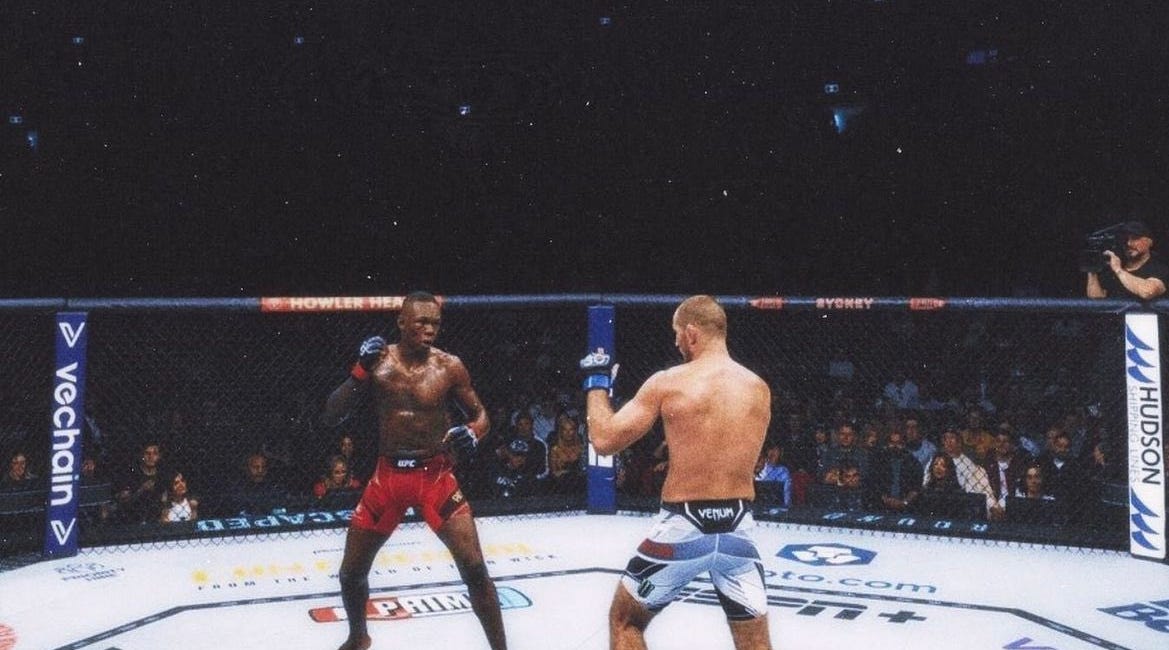Derailing the One Track Plan
Dricus du Plessis vs. Sean Strickland II at UFC 312
LUMPIN-DDP
Contents:
DriKickUs
Countering the Jab
Dealing with the Teep
Dricus du Plessis has again proved why he is one of my favorite champions in the sport right now. He is a man of contradictions. His boxing and wrestling is ugly and brutish (Chad-coded), yet he has surprisingly dextrous kicks. He talks of analysts over-thinking his fighting, but he comes into every fight with smart tactics and in-fight adjustments.
‘Still Knocks’ does not appear to pass the eye test, but succeeds in spite of it. Despite an initially competitive and somewhat repetitive first fight, du Plessis came prepared to deal with Strickland’s rote approach in the rematch. This was not a surgical dissection you might see from fighters like Volkanovski or Weili. It was instead du Plessis’ unique quirks forming entertaining and inventive counters to Stricklands game.
V1: du Plessis breaks Strickland’s nose
Disclaimer: The video clips included in this article are not owned by the author. They are included for educational purposes only to illustrate key moments in the fighter’s career and demonstrate aspects of mixed martial arts techniques and strategies. All rights to the video content belong to their respective owners.
If you would like free breakdowns on his game, check these articles out:
Making Things Ugly: Dricus Du Plessis & Andrew Tackett
UFC 305 and the CJI were showcases in how being a technical savant is not always the best base for success. Those who might seem less technically refined or use less conventional styles can often fin…
Ugly Tacticians vs. Beautiful Technicians
Sean Strickland pulled off something few thought possible last Saturday night: He fundamentally dismantled Israel Adesanya.
DriKickUs
Lumpin-DDP first caught my attention in the Adesanya fight and only solidified as a cornerstone of his game at UFC 312. Of all the things the top-heavy oaf could add to his game, a great question mark kick was near the bottom of my expectations (V2, V5). When I refer to something as a ‘cornerstone’ of a fighters game, I realize that term can be somewhat nebulous. Here, and in most cases, it means thus:
A technique or tactic in which a fighters other actions stem from, or which induce in the opponent things for the fighter to take advantage of. Often times this is what they are doing in the 'dead spaces' of a fight, where they are not exchanging, but the fighter simply wants to stay busy and continue to induce action. A fighter uses this 'cornerstone' tactic to build other actions that will swing the fight in his direction. Ex: Dricus' kicks, Frankie Edgar's jab / post-single double attack, Adesanya's jab and calf kick, Stricklands jab and teep.
Du Plessis is often inducing the action with his kicks. They give him information with which to work. Did the question mark kick land? Yes, so keep doing it. Is he now reacting to the threat? Perfect, now kick him in the body.
The question mark / high kick itself is meant to subvert expectations. To be more precise, du Plessis lifting the knee (from both legs in both stances) was the true tactic from which his initiating actions were built. Given Strickland’s own propensity to teep and check kicks, the threat of the knee raise could force a defensive response. We see this response in V3, which is followed by a lead leg high kick thereafter.
A high kick is a risky technique in MMA. It is high commitment, taxing, and leaves a wide opening to be taken down. This matters little here. Strickland is not much of a grappling threat and DDP has deceptively good cardio (he simply always looks tired, while fighting through it). Strickland instead wants to jab at all costs and likes to lean away from shots. The high kick keeps him on the end of kicking range and even if he blocks it (V4, V5), it is a strong enough strike that it can significantly damage the arms (V5).
V2
V3
V4
V5
Countering the Jab
DDP’s kicks and knee raises up the middle created the majority of his initiating action, but how did he take advantage of Strickland’s tools and habits? For all of the criticism of Strickland’s style, most fighters at middleweight simply cannot deal with his straight punching and kick defense. It is simple but effective. That said, Strickland has almost no ancillary tools to fall back on. If his jab and teep are not working consistently, his odd right hand is not going to change the course of a fight. Remove the threat of these weapons, and you will easily impose your will.
DDP was aware of the threat right away, taking the first round to defend against Strickland’s jab with his active high guard and parries (V6). He always put something in the path of the jab. He spent 5 rounds prior finding the feel for this stagnant game, so it did not take DDP long to try and exploit the jab. Unsurprisingly, DDP found his own way. He tried his hand at the ultimate jab killer, the cross counter (V7), but Strickland’s shoulder roll blocked the path of his right.
V6
V7
A more typical response to punishing an opponent leaning behind their shoulder would be to step forward with the left hook. DDP is no typical fighter. Instead, he hops forward with his jab to get Strickland leaning back, and arcs his right hand over Strickland’s shoulder and down to catch his temple inside of Strickland’s counter (V8). Strickland’s own hooks are straight-armed, not nearly tight enough to catch such an exaggerated technique. From the closed-stance, he was able to throw this right hand more conventionally after occupying Strickland’s pawing hands (V9), but the real fun came in the open-stance.
Keep reading with a 7-day free trial
Subscribe to Movement Martials to keep reading this post and get 7 days of free access to the full post archives.





